Surfaces
Table of Contents
5.1 INTRODUCTION
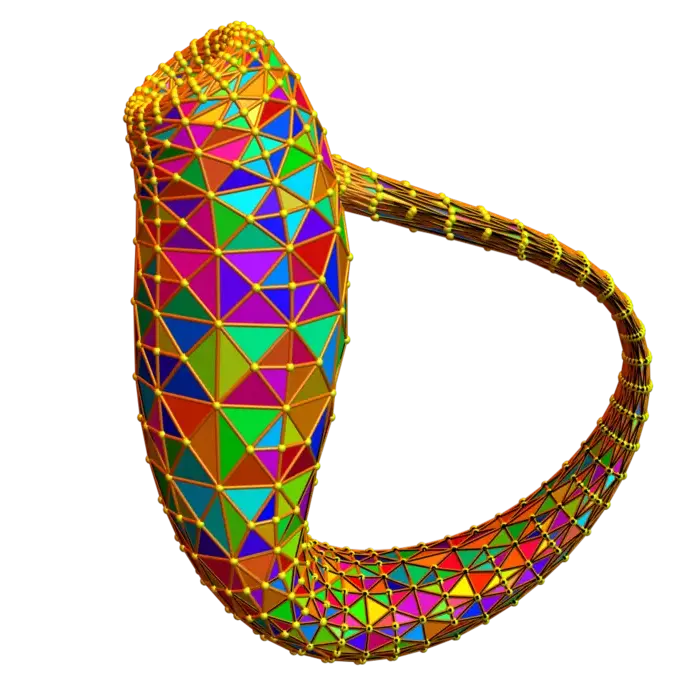
5.1.1 Understanding Surfaces
Surfaces are co-dimension one objects in a space. They are important because they can divide up space. We can confine water in a bottle. This is not possible for co-dimension two. You can not confine water in a curve. Similarly, if you lived in \(4\)-dimensional space, you could not store water in a two-dimensional surface. But things can get tricky already in three dimensions. There are two-dimensional closed surfaces which do not confine any space. Try to drink from a Klein bottle!
5.1.2 Describing Surfaces
A surface can mathematically be described in two fundamentally different ways. It is either given as a level surface of a function on that space. Or then it can be the image of a map called parametrization. You know this from the earth, which is a sphere. We can either say that a sphere is the set of points which have a fixed
distance to its center point. Or then we can parametrize the sphere, for example using longitude and latitude. A plane through the \(0\) can be given either as the kernel \(\left\{x \in \mathbb{R}^{3} \mid A x=0\right\}\) of a \(1 \times 3\) matrix \(A\) or then as the image \(\left\{A x \mid x \in \mathbb{R}^{2}\right\}\) of a \(3 \times 2\) matrix. The first writes \(a x+b y+c z=0\). The second writes the plane as \(v s+w t\), where \(v\), \(w\) are the column vectors of \(A\) and \(x=[s, t]^{T}\) gives the parameters.
5.2 LECTURE
5.2.1 Linear Manifolds and Spaces
If \(A\) is a matrix, the solution space of a system of equations \(A \mathbf{x}=b\) is called a linear manifold. It is the set of solutions of \(A \mathbf{x}=0\) translated so that it passes through one of the points. The equation \(3 x+2 y=6\) for example describes a line in \(\mathbb{R}^{2}\) passing through \((2,0)\) and \((0,3)\). The solutions to \(A x=0\) form a linear space, meaning that we can add or scale solutions and still have again solutions. We can rephrase the just said in that a linear space is a linear manifold which contains \(0\) . For example, for \(x+2 y+3 z=6\) we get a plane which is parallel to the plane \(x+2 y+3 z=0\). The former is a linear manifold (also called affine space), the later is a linear space. It is the solution space to \(A \mathbf{x}=0\) with \(A=[1, 2, 3]\) and \(\mathbf{x}=[x, y, z]^{T}\). Both planes are perpendicular to \(n=[1,2,3]^{T}\). To find an equation for the plane through \(3\) points \(P, Q, R\), define \(n=P Q \times P R=[a, b, c]^{T}\) then write down \(a x+b y+c z=d\), where \(d\) is obtained by plugging in a point. The cross product comes handy.
5.2.2 Normal Vectors and Planes
The following important example deals with \(A=\left[a_{1}, \ldots, a_{m}\right]\) in \(M(1, m)\).
Theorem 1. The vector \(n=A^{T}\) is perpendicular to the plane \(A x=d\).
Proof. Given two points \(y\), \(z\) in the plane. Then we have \(A y=d\) and \(A z=d\). Then \(x=y-z\) is a vector inside the plane. Now \(A^{T} \cdot x=A x=A(y-z)=A y-A z=d-d=0\). This means that \(x\) is perpendicular to the vector \(A^{T}\). ◻
In three dimensions, this means that the plane \(a x+b y+c z=d\) has a normal vector \(A^{T}=n=[a, b, c]^{T}\). Keep this in mind, especially because \(\mathbb{R}^{3}\) is our home.
5.2.3 Kernels and Images of Matrices
This duality result will later will identified as a fundamental theorem of linear algebra. It will be important in data fitting for example. The kernel of a matrix \(A\) is the linear space of all solution \(A x=0\). The kernel consists of all roots of \(A\). The image of a matrix \(A\) is the linear space of all vectors \(\{A x\}\). We abbreviate \(\operatorname{ker}(A)\) for the kernel and \(\operatorname{im}(A)\) of the image. We will come back to this later.
Theorem 2. The image of \(A^{T}\) is perpendicular to the kernel of \(A\).
Proof. If \(x\) is in the kernel of \(A\), then \(A x=0\). This means that \(x\) is perpendicular to each row vector of \(A\). But this means that \(x\) is perpendicular to the column vector of \(A^{T}\). So, \(x\) is perpendicular to the image of \(A^{T}\). This line of argument can be reversed to see that if \(x\) is perpendicular to the image of \(A^{T}\), then it is in the kernel of \(A\). ◻
5.2.4 Exploring Non-Linear Surfaces
Given a function \(f: \mathbb{R}^{n} \rightarrow \mathbb{R}\), the solution set \(\left\{f\left(x_{1}, \ldots, x_{n}\right)=d\right\}\) is a hyper surface. We often say "surface" even so "surface" is reserved to \(n=3\). The simplest non-linear surfaces are quadratic manifolds \[x \cdot B x+A x=d\] defined by a symmetric matrix \(B\) and a row vector \(A\) and a scalar \(d\). We assume that \(B\) is not the zero matrix or else, we are in the case of a linear manifold. We also can assume \(B\) to be symmetric \(B=B^{T}\). For notation, we write \[\operatorname{Diag}(a, b, c) = \begin{bmatrix} a & 0 & 0 \\ 0 & b & 0 \\ 0 & 0 & c\end{bmatrix}\] and \(1=\operatorname{Diag}(1,1,1)\).
5.2.5 Ellipsoids
For \(B=1\) and \(A=0\) and \(d=1\) we get the sphere \(|x|^{2}=1\). In \(\mathbb{R}^{2}\), a sphere is a circle \(x^{2}+y^{2}=1\). In three dimensions we have the familiar sphere \(x^{2}+y^{2}+z^{2}=1\). An more general ellipsoid with \(B=\operatorname{Diag}\left(1 / a^{2}, 1 / b^{2}, 1 / c^{2}\right)\) is \(x^{2} / a^{2}+y^{2} / b^{2}+z^{2} / c^{2}=1\). By intersecting with \(x=0\) or \(y=0\) or \(z=0\), we see traces, which are all ellipses.
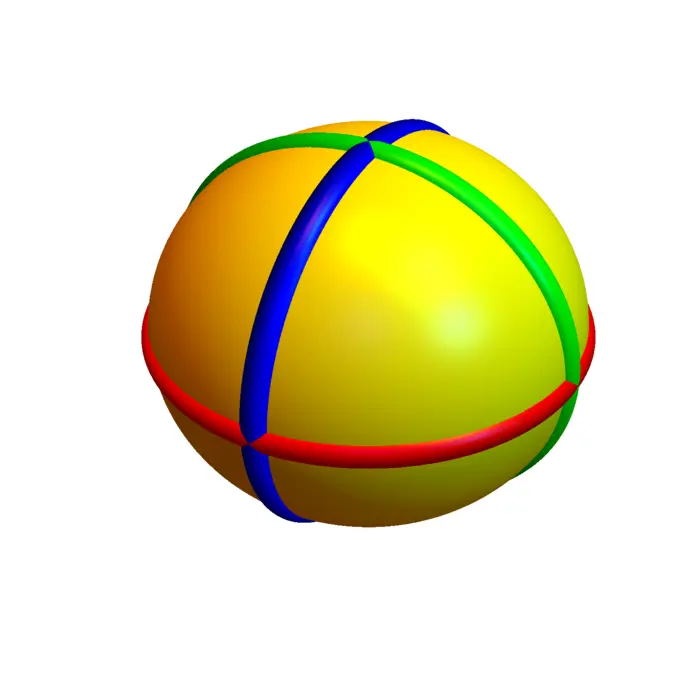
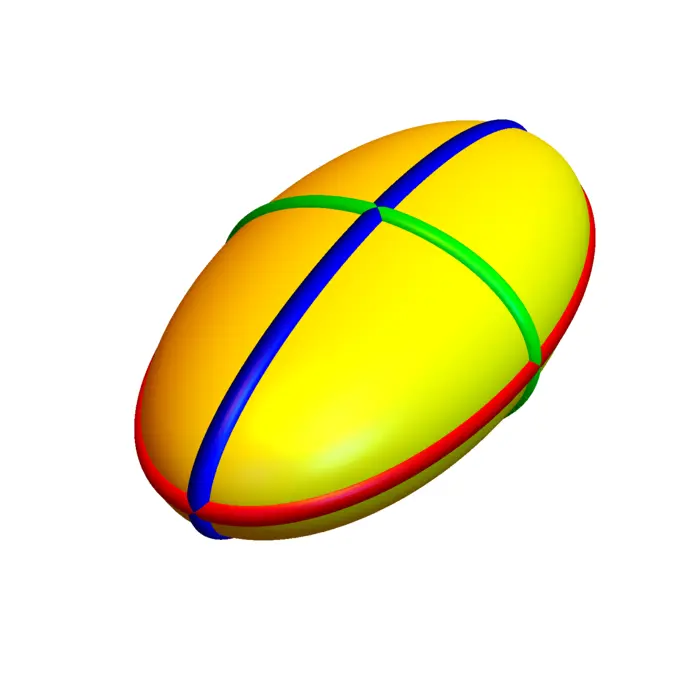
5.2.6 Hyperboloids
For \(B=\operatorname{Diag}(1,1,-1)\) and \(d=1\), we get a one-sheeted hyperboloid \(x^{2}+y^{2}-z^{2}=1\). For \(B=\operatorname{Diag}(1,1,-1)\) and \(d=-1\), we get a two-sheeted hyperboloid \(x^{2}+y^{2}-z^{2}=-1\). A more general hyperboloid is of the form \(x^{2} / a^{2}+y^{2} / b^{2}-z^{2} / c^{2}=d\) with \(d \neq 0\). The intersection with \(z=0\) gives in the one-sheeted case a circle, in the two-sheeted case nothing. The \(x=0\) trace or the \(y=0\) trace are both hyperbola.
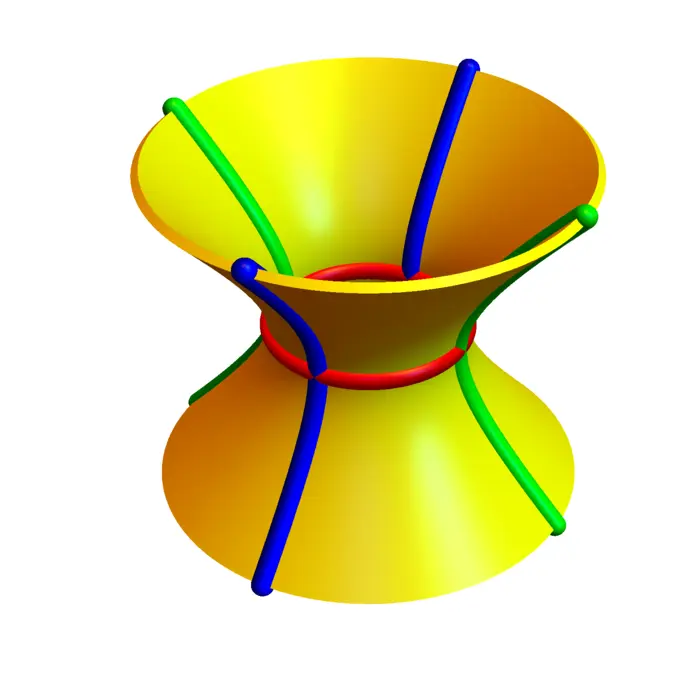
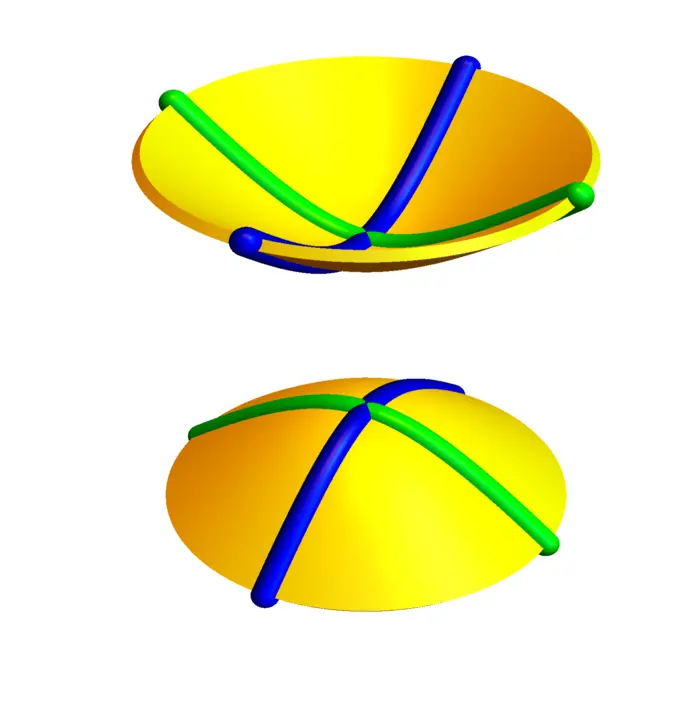
5.2.7 Paraboloids
For \(B=\operatorname{Diag}(1,1,0)\) and \(A=[0,0,-1]\) and \(d=0\) we get the paraboloid \(x^{2}+y^{2}=z\), for \(B=\operatorname{Diag}(1,-1,0)\) and \(A=[0,0,-1]\) and \(d=0\) we get the hyperbolic paraboloid \(x^{2}-y^{2}=z\). We can recognize paraboloids by intersecting with \(x=0\) or \(y=0\) to see parabola. Intersecting the elliptical paraboloid \(x^{2}+y^{2}=z\) with \(z=1\) gives an ellipse. Intersecting the hyperbolic paraboloid \(x^{2}-y^{2}=z\) with \(z=1\) gives a hyperbola.
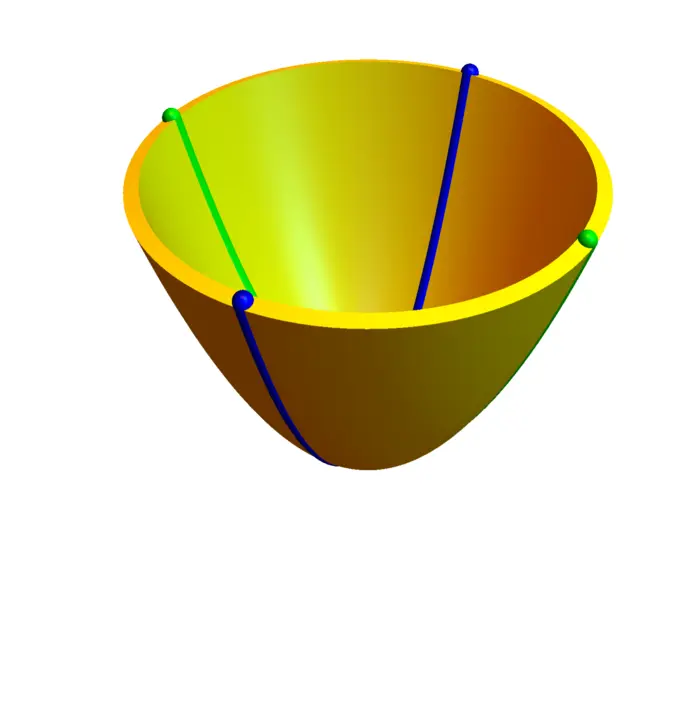
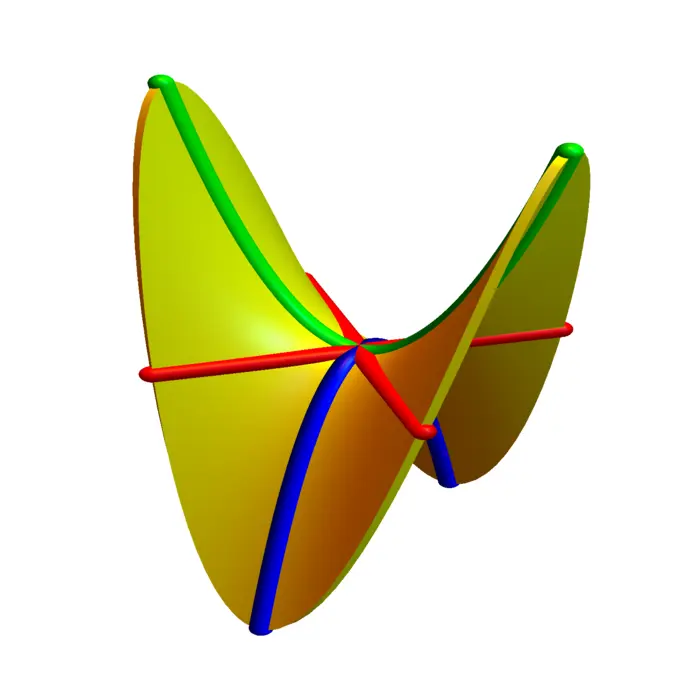
5.2.8 Special surfaces
If \(B=\operatorname{Diag}(1,1,-1)\) and \(d=0\), we get a cone \(x^{2}+y^{2}-z^{2}= 0\). For \(B=\operatorname{Diag}(1,1,0)\) and \(d=1\) we get the cylinder \(x^{2}+y^{2}=1\).
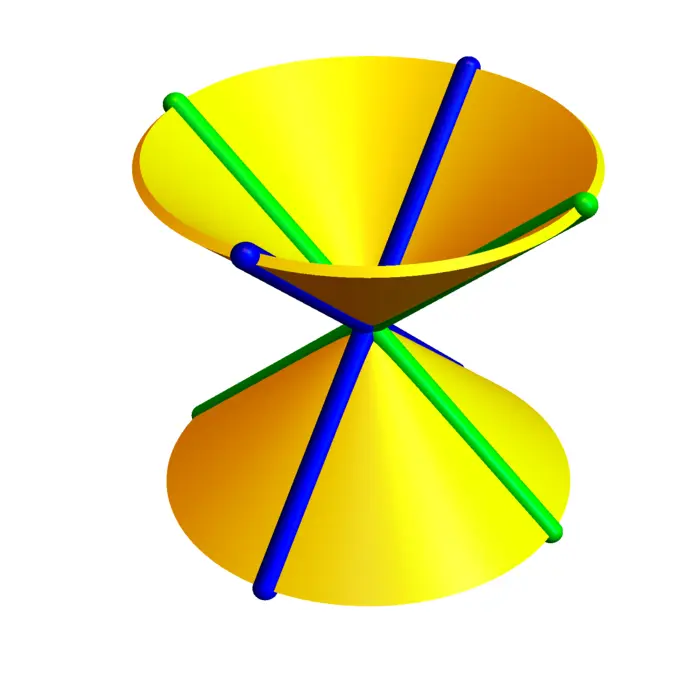
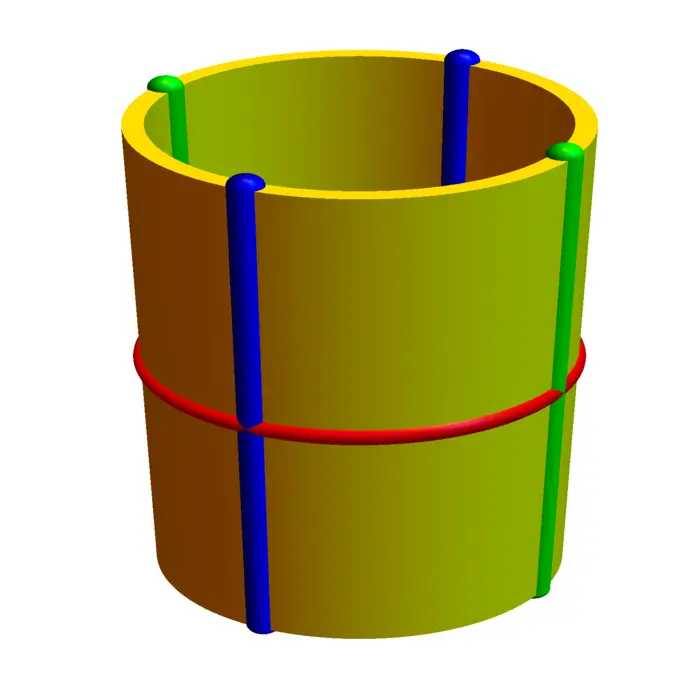
5.2.9 Side Remark: Algebraic Structures and Forces
The \(1\)-sphere \(S^{1}=\left\{x^{2}+y^{2}=1\right\} \subset \mathbb{R}^{2}\) and the \(3\)-sphere \(S^{3}=\left\{x^{2}+y^{2}+z^{2}+w^{2}=1\right\} \subset \mathbb{R}^{4}\) carry a multiplication: \(S^{1}\) is in the complex numbers \(\mathbb{C}=\{x+i y\}\) and \(S^{3}\) is in the quaternions \(\mathbb{H}=\{x+i y+j z+k w\}\). The \(1\)-sphere is the gauge group for electromagnetism, the \(3\)-sphere (also called \(S U(2)\)) is responsible for the weak force. No other Euclidean sphere carries a multiplication for which \(x \rightarrow x * y\) is smooth. Michael Atiyah once pointed out that this algebraic particularity might not be a coincidence and responsible for the structure of the standard model of elementary particles (one of the most accurate theories ever built by humanity). The strong force appears as one can let a set of \(3 \times 3\) matrices \(S U(3)\) act on \(\mathbb{H}\). Atiyah suggested that gravity could be related to the octonions \(\mathbb{O}\). There \(S^{7}=\{|x|=1\} \subset\) \(\mathbb{R}^{8}\) carries still a multiplication, but it is no more associative. The list of normed division algebras \(\mathbb{R}\), \(\mathbb{C}\), \(\mathbb{H}\) and \(\mathbb{O}\).1
5.2.10 Polynomial Surfaces: Varieties
Given a polynomial \(p\) of \(n\) variables, one can look at the surface \(\{p(x)=0\}\). It is called a variety.
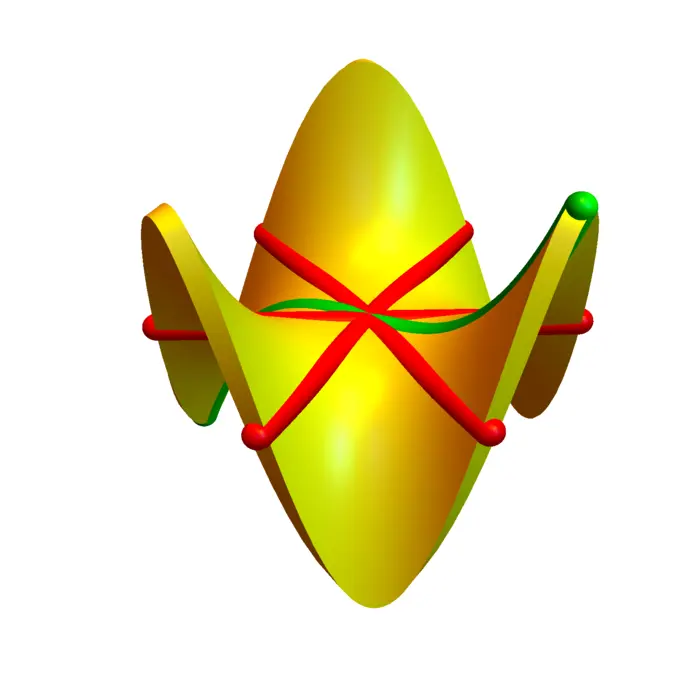
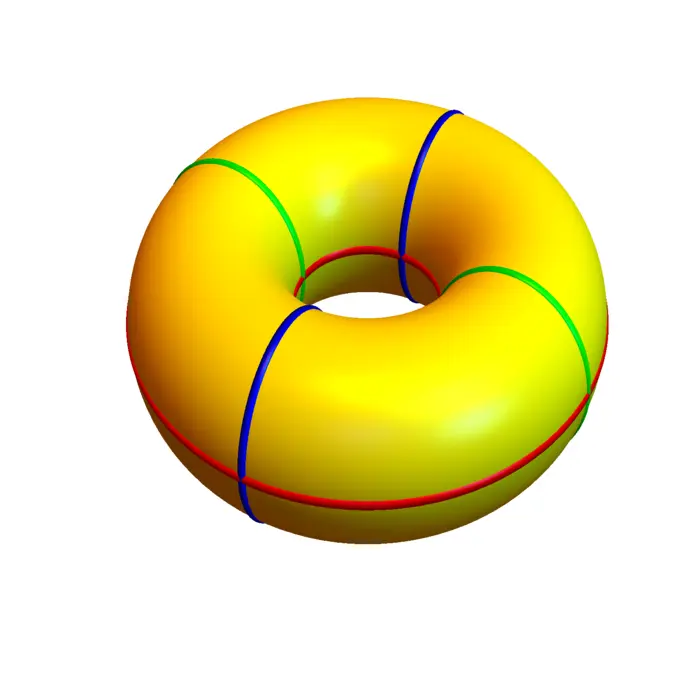
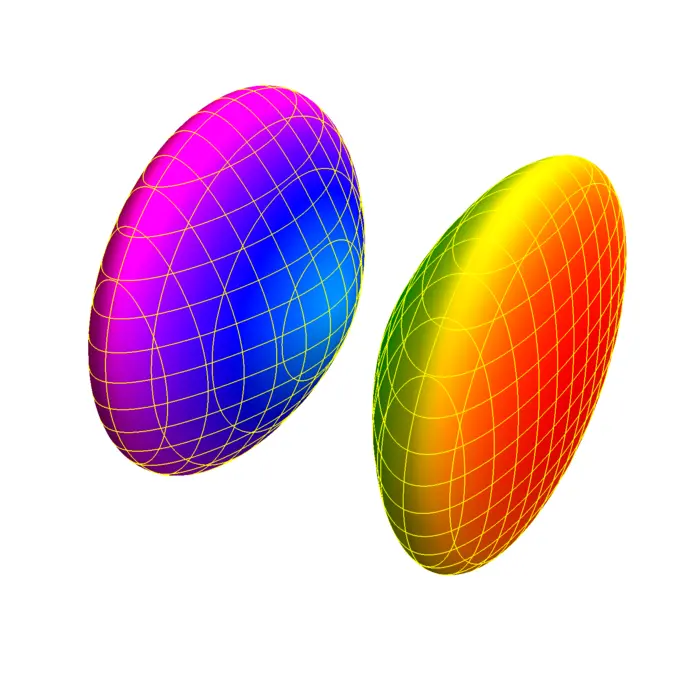
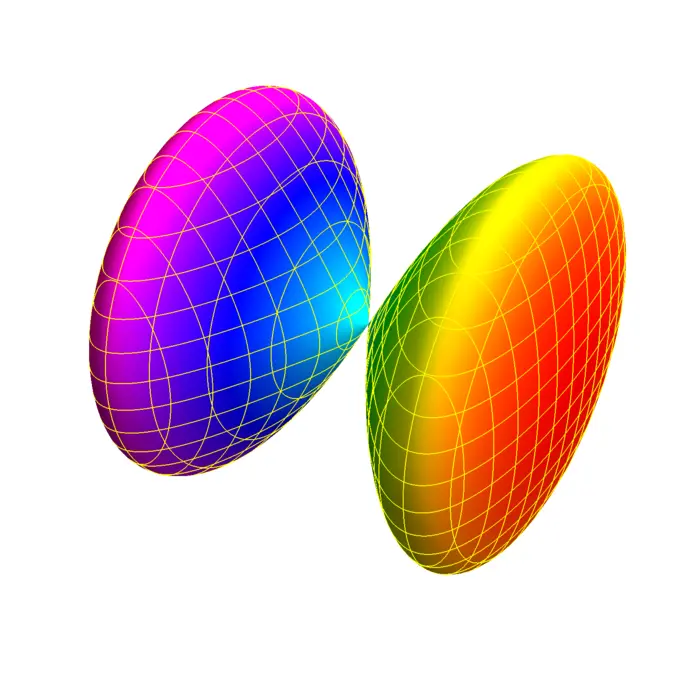
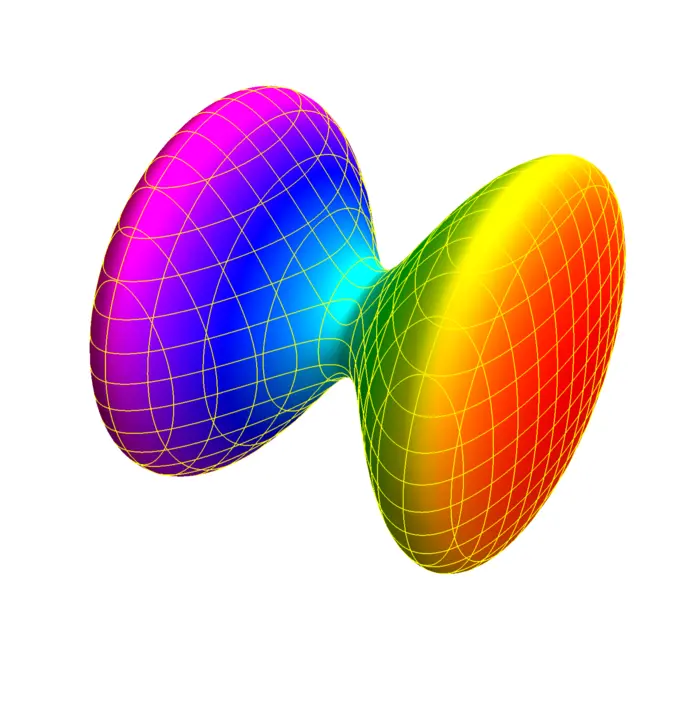
5.3 EXAMPLES
Example 1. Q: Find the plane \(\Sigma\) containing the line \(x=y=z\) and the point \(P=(3,4,5)\).
A: \(\Sigma\) contains \(Q=(0,0,0)\) and \(R=(1,1,1)\) and so the vectors \(v=[1,1,1]^{T}\) and \(w=[3,4,5]^{T}\). The cross product between \(v\) and \(w\) is \([1,-2,1]^{T}\). It is perpendicular to \(\Sigma\). So, the equation is \(x-2 y+z=d\), where \(d\) can be obtained by plugging in a point \((3,4,5)\). This gives \(d=0\) so that \(x-2 y+z=0\).
Example 2. Can we identify the surface \(x^{2}+2 x+y^{2}-4 y-z^{2}+6 z=0\)? Completion of the square gives \[x^{2}+2 x+\boxed{1}+y^{2}-4 y+\boxed{4}-z^{2}+6 z-\boxed{9}=\boxed{1} + \boxed{4} - \boxed{9}=-4.\] Now \((x+1)^{2}+(y-2)^{2}-(z-3)^{2}=-4\). This is a two-sheeted hyperboloid centered at \((-1,2,3)\).
Example 3. Intersecting the cone \(x^{2}+y^{2}=z^{2}\) with the plane \(y=1\) gives a hyperbola \(z^{2}-x^{2}=1\). Intersection with \(z=1\) gives a circle \(x^{2}+y^{2}=1\). Intersecting with \(z=x+1\) gives \(y^{2}=2 x+1\), a parabola. Because bisecting a cone can give hyperbola, an ellipse or a parabola as cuts, one calls the later conic sections.
Example 4. The case of singular quadratic manifolds is even richer: \(x^{2}-y^{2}=1\) is a cylindrical hyperboloid, \(x^{2}-y^{2}=0\) is a union of two planes \(x-y=0\) and \(x+y=0\). The surface \(x^{2}=1\) is a union of two parallel planes, the surface \(x^{2}=0\) is a plane.
EXERCISES
Exercise 1.
- What kind of curve is \(2 x^{2}+4 x+2 y^{2}+2=0\)?
- What surface is \(x^{2}+y^{2}-4 y+z^{2}+8 z=100\)?
- Let \((x, y, z)\) be the set of points for which \(\left|[x, y, z]^{T} \times[1,1,1]^{T}\right|=1\). Describe this set.
Exercise 2.
- What kind of curves can you get when you intersect hyperbolic paraboloid \(x^{2}-y^{2}=z\) with a plane?
- Explore what you get if you intersect the hyperboloid \(S: x^{2}+y^{2}-z^{2}=1\) with the \(S\) rotated by \(90\) degrees around the \(x\)-axes.
Exercise 3. Find explicit planes which when intersected with the hyperboloid \(x^{2}+2 y^{2}-z^{2}=1\) produces an ellipse, or a hyperbola or a parabola.
Exercise 4. Find the equation of a plane which is tangent to the three unit spheres centered at \((3,4,5)\), \((1,1,1)\), \((2,3,4)\).
Exercise 5. Build a concrete function \(f(x, y, z)\) of three variables such that some level surface \(f(x, y, z)=c\) is a pretzel, a surface with three holes. Hint: the surface \(g * h=0\) is the union of the surfaces \(g=0\) and \(h=0\). Now, \(g * h=c\) can produce surfaces in which things are glued nicely. If you should look up a surface on the web or literature, you have to give the reference. You can use the computer to experiment, or then describe your strategy in words.
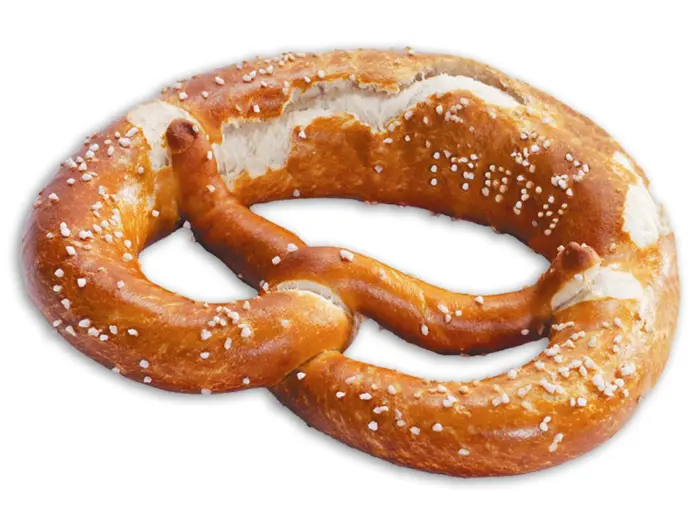
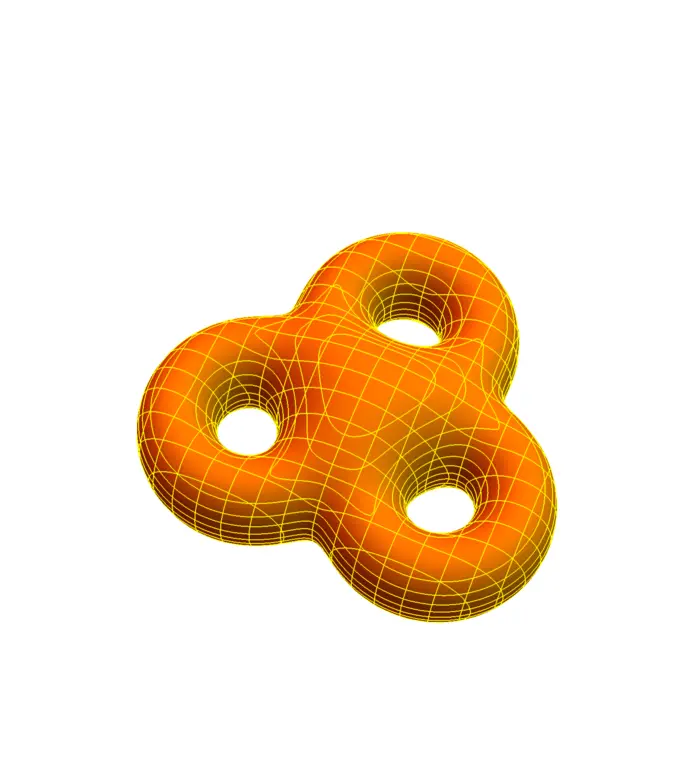
- See the talk of 2010 of Atiyah (https://www.youtube.com/watch?v=zCCxOE44M_M).↩︎